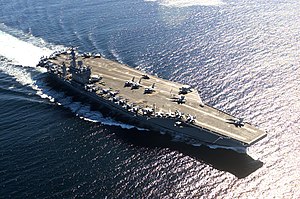
| Part of a series on |
| War (outline) |
|---|
 |
Power projection (or force projection or strength projection) in international relations is the capacity of a state to deploy and sustain forces outside its territory.[1] The ability of a state to project its power into an area may serve as an effective diplomatic lever, influencing the decision-making processes and acting as a potential deterrent on other states' behavior.[2][3][4][5]
This ability is a crucial element of a state's power in international relations. Any state able to direct its military forces outside its territory might be said to have some level of power projection capability, but the term itself is used most frequently in reference to militaries with a worldwide reach (or at least significantly broader than a state's immediate area). Even states with sizable hard power assets (such as a large standing army) may only be able to exert limited regional influence so long as they lack the means of effectively projecting their power on a global scale. Generally, only a select few states are able to overcome the logistical difficulties inherent in the deployment and direction of a modern, mechanized military force.[6][7] Allies and partners can take up or share some of the burden of power projection.[8][9][10] One measure of the capability of a state to project power is the loss-of-strength gradient, until a culminating point is apparent to others, once an operation is underway.
A state might § compete in the gray zone just short of conflict, exercising its soft power, or hard power, in a bid for potential superpower.[11][12]: 1:47 [a] While traditional measures of power projection typically focus on hard power assets (tanks, soldiers, aircraft, naval vessels, etc.), the use of soft power shows that power projection does not necessarily have to actively put military forces in combat, but only potentially.[13] Assets for power projection can often serve dual uses, as the deployment of various countries' militaries during the humanitarian response to the 2004 Indian Ocean earthquake illustrates.
- ^ US Department of Defense (2013). The Dictionary of Military Terms. New York: Skyhorse Publishing. ISBN 9781628730197.
- ^ Bartosz Głowacki (4 Feb 2022) What weapons will Poland send to Ukraine – and is an alliance next?
- ^ Reuters (February 1, 2022) Factbox-How Ukraine's armed forces shape up against Russia's
- ^ Pravda (Правда) (17 Mar 2022) Zelenskyy explained the essence of the new military alliance U24 from Zelenskyy's night address verbatim: "I addressed the United States and all responsible states with a proposition to create a new U24 union: a new union that will ensure that each aggressor receives a coordinated world response quickly, effectively, and immediately - not in weeks, months, years, but for the first 24 hours after the attack." "We can no longer trust existing institutions. We cannot expect bureaucrats in international organisations to change fast enough, so we must look for new guarantees, create new tools, and to build alliances with those who have the courage to do what justice demands."
- ^ Salamah Magnuson, Morgan Keay, Kimberly Metcalf (Spring 2022) Countering Hybrid Warfare: Mapping Social Contracts to Reinforce Societal Resiliency in Estonia and Beyond
- ^ Michael J. Mazarr (15 Apr 2020) Toward a New Theory of Power Projection
- ^ Cite error: The named reference
whyAndWhatwas invoked but never defined (see the help page). - ^ Katie Lange (8 Oct 2018) National Defense Strategy: Alliances and Partnerships
- ^ Ian Ward (23 Feb 2022) Joe Biden’s Secret Constitutional Weapon
- ^ Andrew Desiderio, Tara Palmeri and Meridith McGraw (23 Feb 2022) Republicans descend into foreign policy factionalism over Russia-Ukraine standoff
- ^ Matthew Brown (February 1, 2022) Putin says US, NATO have 'ignored' Russia's security demands on Ukraine: What we know
- ^ Russia Insight (February 1, 2022) BREAKING! Putin: USA Is Using Ukraine As ‘Tool’ To Contain Russia 8:01 Video clip, English closed captions
- ^ Cite error: The named reference
joshiwas invoked but never defined (see the help page).
Cite error: There are <ref group=lower-alpha> tags or {{efn}} templates on this page, but the references will not show without a {{reflist|group=lower-alpha}} template or {{notelist}} template (see the help page).